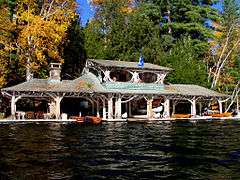Camp Topridge
|
Camp Topridge | |
|
The boathouse at Topridge | |
  | |
| Location | S of Keese Mills Rd., Upper St. Regis Lake, Keese Mill, New York |
|---|---|
| Coordinates | 44°25′15″N 74°18′07″W / 44.42083°N 74.30194°WCoordinates: 44°25′15″N 74°18′07″W / 44.42083°N 74.30194°W |
| Area | 105 acres (42 ha) |
| Built | 1923 |
| Built by | Muncil, Benjamin |
| Architect | Blake, Theodore |
| Architectural style | Adirondack rustic |
| MPS | Great Camps of the Adirondacks TR |
| NRHP Reference # | 86002952[1] |
| Added to NRHP | November 7, 1986 |
Camp Topridge is an Adirondack Great Camp bought in 1920 and substantially expanded and renovated in 1923 by Marjorie Merriweather Post, founder of General Foods and the daughter of C. W. Post. The "camp", near Keese Mill, in the U.S. state of New York, was considered by Post to be a "rustic retreat"; it consisted of 68 buildings, including a fully staffed main lodge and private guest cabins, each staffed with its own butler. It was one of the largest of the Adirondack great camps and possibly the most elaborately furnished.[2]
The camp had 207 acres (84 ha) and was situated on an esker between the Spectacle Ponds and Upper St. Regis Lake, about 12 miles (19 km) northwest of Saranac Lake, New York.
As originally built, the property could only be reached by water, though a driveway was added in later years. Guests arrived by float-plane or Post's yacht at a private dock, and thence via funicular to the main building at the top of the ridge. Three times a week, guests would gather in the 65-by-50-foot (20 by 15 m) living room where full-length movies could be screened; an adjoining dining room seated thirty guests. Many of the original furnishings of the room, which included an extensive collection of American Indian artifacts, are now in the Smithsonian Institution. Among the many elaborate structures on the property is a Russian dacha built for Post's third husband, who had served as ambassador to the Soviet Union.
The staff would arrive from Keese Mills Road in Paul Smiths and drive around the water and leave their cars in a parking lot, now used as public parking for the trail to St. Regis Mountain; the trail head is just before the private property line of Camp Topridge. From the parking lot, staff would walk a hilly, unpaved path into the workers' side of the camp. In the early 1970s, this unpaved path was widened and became suitable for one-way car traffic. Prior to the paving, vehicles could only be driven over the ice in the winter. Mrs Post's guests would arrive at Saranac Airport (in Lake Clear), often in her private Vickers Viscount, the Merriweather. They would be driven to a launch which would take them to one of the boat houses. From there, they could either take the stairs or ride a covered, six-person electronic lift or funicular, installed for Mrs. Post's aunt Molly Post, who suffered from heart trouble. When Mrs. Post was in camp, it provided employment to carpenters, painters, maids and general labor. For years, the caretaker of the camp and his wife would feed lunch to staff in a dining room in the caretaker's home and this was one of the benefits of working for Mrs. Post at the time.
The estate was designed by local builder Ben Muncil in collaboration with New York architect Theodore Blake.[2]
Post left the property to the State of New York.[2] The main lodge, most of the buildings and 105 acres (42 ha) were offered for sale, with the remaining acreage to be made part of the Adirondack Forest Preserve. Roger Jakubowski purchased the Camp from the State of New York in 1985 for $911,000.[3] It is now owned by Texas real estate magnate Harlan Crow, who has substantially restored the buildings and added a number of new ones.
The property was listed on the National Register of Historic Places in 1986.[1]
Gallery
-

The second boathouse at Topridge, added by Harlan Crow
-

A newer building between the two boathouses.
-

Closeup of the antique boats.
-

Closeup of the Harlan Crow boathouse.
Notes
- 1 2 National Park Service (2010-07-09). "National Register Information System". National Register of Historic Places. National Park Service.
- 1 2 3 "Cultural Resource Information System (CRIS)" (Searchable database). New York State Office of Parks, Recreation and Historic Preservation. Retrieved 2015-11-01. Note: This includes Raymond W. Smith and Richard Youngken (July 1986). "National Register of Historic Places Registration Form: Camp Topridge" (PDF). Retrieved 2015-11-01. and Accompanying photographs
- ↑ http://www.nytimes.com/1985/11/14/garden/great-camp-in-adirondacks-is-passing-into-private-hands.html. Missing or empty
|title=(help)
Sources
- Kaiser, Harvey H., Great camps of the Adirondacks. Boston: David R. Godine, 1982. ISBN 0-87923-308-7.


